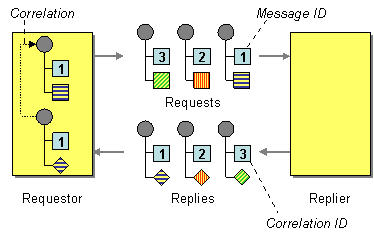Since we're on a major migration process of this website, some component documents here are out of sync right now. In the meantime you may want to look at the early version of the new website
https://camel.apache.org/staging/
We would very much like to receive any feedback on the new site, please join the discussion on the Camel user mailing list.
Correlation IdentifierCamel supports the Correlation Identifier from the EIP patterns by getting or setting a header on a Message. When working with the ActiveMQ or JMS components the correlation identifier header is called JMSCorrelationID. You can add your own correlation identifier to any message exchange to help correlate messages together to a single conversation (or business process). The use of a Correlation Identifier is key to working with the Camel Business Activity Monitoring Framework and can also be highly useful when testing with simulation or canned data such as with the Mock testing framework Some EIP patterns will spin off a sub message, and in those cases, Camel will add a correlation id on the Exchange as a property with they key The following example demonstrates using the Camel JMSMessageID as the Correlation Identifier within a request/reply pattern in the JMS component Using the Fluent Builders from("direct:start")
.to(ExchangePattern.InOut,"jms:queue:foo?useMessageIDAsCorrelationID=true")
.to("mock:result");
Using the Spring XML Extensions <route> <from uri="direct:start"/> <to uri="jms:queue:foo?useMessageIDAsCorrelationID=true" pattern="InOut"/> <to uri="mock:result"/> </route> See Also |

